Managing the Spring Pasture Flush
ID
SPES-486P
EXPERT REVIEWED
What Is the Spring Flush?
In areas such as Virginia that rely primarily on cool-season grass pastures, a disproportionate amount of a season’s yield occurs in spring, often exceeding livestock demand (fig. 1). Because Virginia transitions relatively quickly from spring to summer, cool-season grasses also tend to mature rapidly within a short time frame. Much of the spring yield is stemmy growth, high in fiber, which supports relatively low rates of animal performance. Furthermore, tall fescue — the dominant forage species in most of Virginia — contains a toxic alkaloid that typically reaches peak levels as the plant matures, further reducing animal performance. This phenomenon of rapidly maturing pasture and steadily declining forage quality is often referred to as the “spring flush.”

Why Should I Actively Manage the Spring Flush?
Spring grazing management sets the stage for the optimal health and regrowth potential of grasses and legumes throughout the growing season. During early spring green-up, when the new cycle of plant growth begins, management should focus on preventing overgrazing that can reduce season-long pasture productivity in affected fields (Griggs 2010). Appropriate grazing management beginning in spring can also help to minimize the patchwork of overgrazed and undergrazed areas that often develop in pastures (photo 1), as well as to reduce subsequent weed invasion.

Grazing used to manage the quantity of grass present can minimize the need for mechanical clipping or harvest, reduce grass competition to legumes, and maintain aesthetics. Additionally, grazing management that promotes leafy, vegetative growth improves forage quality during the spring flush is needed to meet the nutritional needs of lactating, breeding, or growing animals. Perhaps most importantly, capturing excess spring pasture production for later use through haymaking or stockpiling can help extend the overall grazing season for better profitability (Burdine et al. n.d.).
While year-to-year variations in weather make it difficult to make predictions about the springflush, this publication introduces several practices that farmers can use in developing a general grazing plan or responding to changing farm conditions.
How Do I Deal with Lush Spring Forage?
Forage moisture content in early spring is often as high as 75-85%, which presents some nutritional challenges. Livestock on lush pasture, especially lactating or growing animals, can reach rumen capacity before they have consumed enough dry matter to meet their energy needs. During early spring when grasses are short, livestock may not be able to take enough bites or graze long enough to meet intake requirements. Spring grasses prior to the transition phase are typically low in fiber content as well. When coupled with high moisture content, the rate of passage through the animal for low-fiber forages can be fast, limiting nutrient absorption in addition to creating loose stools. Fortunately, lush pasture and the problems associated with it are generally short-lived. Loose stools in livestock do not necessarily indicate a problem. If animals with loose stools do not appear lethargic, wormy, or hungry, there is probably not a need for concern. Care should be taken to ensure that animals do not lose body condition (Pasha et al. 1994 and Meteer 2017).
One strategy for dealing with overly lush pasture includes delaying turnout until forage supply and dry matter content are higher. Another strategy is to provide quality dry hay that animals will find palatable. However, many farmers claim that their livestock ignore hay when pasture is available. Similarly, some producers carry over some fall-stockpiled pasture that is higher in fiber for use during early spring. In most cases, this stockpiled pasture has good forage quality.
Grass tetany
Grass tetany is a major concern on lush pasture, especially in early spring. Grass tetany is a potentially lethal metabolic disease in ruminants caused by a magnesium deficiency in the diet. Forages tend to take up magnesium poorly when soils are cool, and high soil potassium and fertilization with nitrogen can worsen the problem. Grass tetany is most prevalent in lactating cattle, particularly older cows with high milk production.
Grass tetany can be prevented by supplementing cows with 0.5-1.0 ounces of supplemental magnesium per day during the high-risk period. Magnesium is not effectively stored in the body, so supplementation is only cost-effective during the high-risk periods of late winter/early spring and fall. Several commercial high magnesium mineral options are available. Commonly called high-mag blocks or mixes, these should contain about 14% magnesium. The targeted intake should be 4 ounces per head per day. With any high-mag mineral mix, be sure to remove all other sources of salt from the cattle’s diet. Monitoring magnesium supplement intake is important to ensure that cattle are consuming the supplement at a level that provides protection. It is a mistake to believe that lower-than-expected consumption is due to a lack of need on the cow’s part. More likely it is an indication of the palatability of the mineral mix. Low mineral consumption can be caused by poor mineral feeder placement or an inadequate number of feeders for the number of cows. Locate the feeders in the high traffic or loafing areas and provide one feeder for every 20 cows. This will enable cows at the bottom of the herd pecking order to consume enough minerals (McCann 2009).
Frothy bloat
Very lush pastures, particularly those with a legume content greater than 50%, can present an increased risk of frothy bloat. Frothy bloat is caused when soluble leaf proteins form a stable foam layer on top of the rumen’s contents. If this layer prevents the animal from belching, continued fermentation can cause gases to push against the diaphragm, potentially suffocating the animal.
Generally, ruminants can adapt to a high legume diet if it is introduced gradually. However, quick or frequent diet changes prevent rumen microbes and animals from adapting to high bloat-potential pastures. Many cases of bloat occur when hungry livestock gorge themselves after being turned into a new pasture with abundant clover or alfalfa. The issue is worsened when forage is wet with rain or dew, in part because cloudy weather results in greater protein concentrations that support foam formation (Rasby, Anderson, and Randle 2010). Once grazing begins, don’t remove animals from pasture or make frequent major changes in the type of pasture being grazed unless animals have greatly distended rumens. Mild bloat is common on high bloat-potential pastures.
Several bloat-prevention blocks and feed products with the active ingredient poloxalene are commercially available. Some producers supplement with quality grass hay to dilute the intake of lush legumes, but animals do not always choose to consume hay. Using temporary fencing to reduce field size and limit selective grazing of lush plant tips can help prevent bloat on pastures of concern by forcing animals to consume plants or plant parts that don’t cause bloating. Allowing legumes to mature to flowering before grazing can also lower the risk in solid stands or fields with high clover concentration. Severe bloat requires emergency veterinary treatment.
What Is the Right Time to Start Grazing in Spring?
Two main approaches are commonly used for timing the start of spring grazing.
- Feed hay in early spring and allow cool-season grass pastures to grow to an 8-10-inch height before turning cattle out to pasture. Common turnout dates with this approach are typically in late-April to early-May in the Piedmont and Southside and early- to mid-May in the Valley and Ridge region. This method maximizes plant health and season-long pasture pro- ductivity, and it minimizes nutritional issues resulting from high plant moisture and low forage availability in early spring. If the additional forage grown by allow- ing pastures to get a head start are reapportioned for use later in the year (for example, stockpiled during the summer or mechanically harvested), pastures get a head start should more than make up for the hay fed in early spring. For areas in rain shadows, you may want to defer spring grazing simply because weather patterns can turn dry and there may be little moisture to support regrowth. Because this approach essentially intensifies the spring flush, it may not be a good fit for farms that have a light stocking rate or that are unable to mitigate the excess supply of spring forage. Delaying spring turnout requires a spring sacrifice paddock that gets overgrazed and may become muddy and unsanitary for cows that calve in the spring.
- Turn out livestock at green-up. Common turnout dates with this approach are typically in late-March to early-April in the Piedmont and early- to mid- April in the Valley and Ridge region. This method can give livestock the head start they need to better keep up with rapidly growing pastures, but it may also result in overgrazing if plants are grazed too short or grazed repeatedly. A good management approach for farms with light to moderate stocking rates is to delay turnout until pastures have grown to about 4 inches tall, then rotate livestock quickly to prevent animals from grazing regrowth. Some farmers find it helpful to supplement hay to grazing animals during this period to help ensure livestock consume adequate dry matter and energy. It is also wise to have a backup plan (for example, pulling animals into a sacrifice pasture and feeding them hay) to prevent pastures from getting overgrazed if weather turns cold and grass growth slows.
Turnout decisions are often a moving target, made difficult by unpredictable weather. The best approach is to adapt to changing conditions based on the principles of grazing management: avoid grazing pastures shorter than 4 inches to maintain plant health, and rotate livestock soon enough to prevent grazing of regrowth. Regardless of whether your turnout date is too early or too late, rotationally grazing your pastures based on these principles will help their overall performance.
What Are Phases of Grass Growth?
The dominant pasture grasses in Virginia are or- chardgrass and fescue, which go through distinct phases during their cycle of growth and development each spring (fig. 2). Understanding these growth phases will help you fully understand the practices discussed later in this publication (Oregon State University n.d.).

Vegetative phase
New leaves and tender shoots emerge from the perennial plant crown. Forage is very nutritious, but pasture yield is low and water content of the forage is high. During spring, significant root growth occurs in grasses and spring leaf production helps plants recover from winter and supports additional growth and development. Plants that are grazed too closely or frequently during this time will have reduced regrowth potential for the entire season and may also go to seed prematurely. These negative impacts on pasture productivity are often seen when an open-all-the-gates approach is used in early spring.
Transition phase
Responding to environmental triggers involving temperature and light, plants begin a transition to the reproductive phase. Existing shoots begin to form stems and grow upright, and the transition phase continues until the seedhead begins to emerge. Yield increases rapidly, in part because of this reproductive stem development. Pasture is still moderately nutritious, but forage intake and digestibility begin to decline due to increasing plant fiber content. The toxicity of tall fescue increases during this phase, as well.
Hormones associated with reproduction begin to suppress the growth of new shoots and leaves from the plant’s base during the transition phase. This effect continues until the seedhead matures or is removed. Removal of seedheads during or after the transition phase can stimulate new growth from the base of the plant, and this new growth remains leafy and vegetative for the remainder of the growing season.
Reproductive phase
The reproductive phase begins when the seedhead becomes visible. After emerging fully and elongating, the seedhead then flowers and forms seed. This time of seedhead emergence and continued stem growth corresponds with a rapid decline in forage quality. Hormones associated with reproduction continue to suppress the formation of new shoots from the plant’s base, and this continues until seed is mature.
Are There Practices I Can Use To Manage the Spring Flush?
Appropriate management of spring flush can have significant impact on forage production and farm profitability. Several methods for managing spring flush can be applied.
Summer stockpiling
Summer stockpiling involves excluding livestock from a portion of cool-season pasture during spring and summer to store standing forage for grazing in the mid-to-late summer.
The late-summer grazing afforded by summer-stockpiling not only reduces the quantity of forage that must be grazed in spring by delaying its usage, it also can enable fall-stockpiling of adjacent pastures for winter grazing. Virginia Tech researchers developed the following protocol, which has been used by a growing number of farmers to reliably extend their grazing season into February.
Select pasture to be summer-stockpiled and exclude livestock from it (fig. 3). Summer stockpile around 25% of total pasture acres while rotationally grazing the remainder throughout the spring and summer. Stockpiled plants should be allowed to mature without any grazing or mowing. While applying nitrogen to the summer stockpile can boost spring growth, it has not been found to increase final yield.
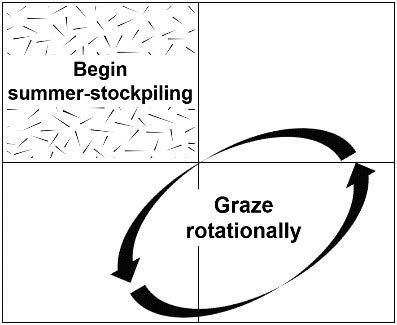
Continue to summer stockpile the previously selected pasture and prepare 50% of total acres for fall stockpiling (fig. 4). Typical preparation for fall stockpiling includes grazing to a height of 3 to 4-inches, possibly clipping to clean up stemmy growth and possibly applying nitrogen. The summer stockpile area will continue to accumulate leafy new growth, and by August, stems and seed heads will dry down and begin to deteriorate.
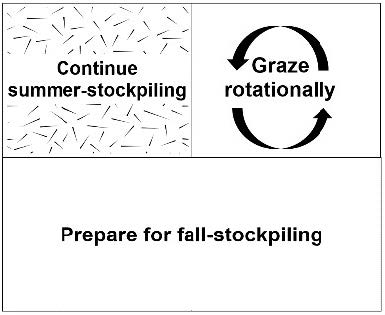
Begin limit-grazing, or strip-grazing, the summer stockpile in mid-August while resting all other pastures (fig. 5, photo 2). The high stocking density made possible by limiting feeding is critical to stretching the forage supply. To optimize use of the forage, use temporary electric wire and tread-in posts to allocate two or three-days’ worth of pasture at a time. Because of the long recovery period that will follow, animals can back graze to the water source without permanently damaging plants. A half acre of good, limit-grazed summer stockpile is needed to provide one and a half to two months of grazing for a mature cow during the late summer and early fall.
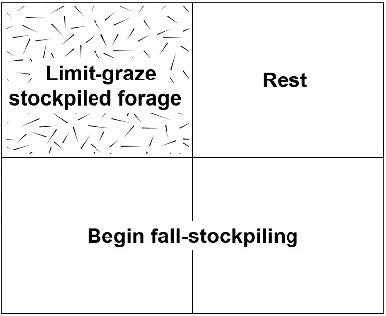

Once the summer stockpile has been depleted, limitgraze the rested pasture that was not dedicated to fall stockpiling (fig. 6). Continue resting the fall-stockpile pasture.
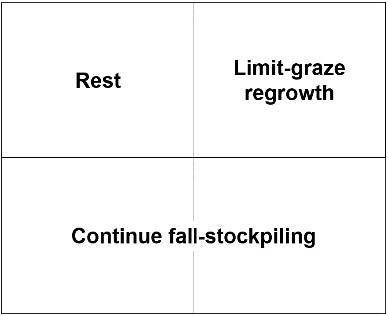
Begin limit-grazing the fall-stockpiled pasture (fig. 7). When 50% of pasture acres are fall stockpiled, this system has consistently extended the grazing season 60 days longer than the conventional grazing season. One acre of good, limit-grazed fall-stockpile is needed to provide 1.5 to two months of grazing for a mature cow during early winter.
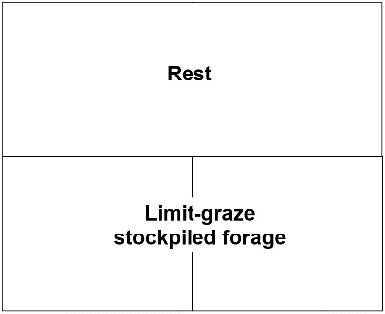
While conventional wisdom would suggest summer stockpiled pasture is of low nutritional value, forage quality testing has shown it to be adequate for beef cows at any stage of production. Studies with spring calving cows on summer stockpile have found no significant dif- ferences in cow body condition or calf weaning weights at the end of the grazing period. Growing or finishing animals, however, would likely require protein and energy supplementation.
Many livestock producers have concerns related to pink eye when grazing cattle on mature forage such as stock- piled summer pasture. While any irritation to the eye can exacerbate pink eye in cattle, there has not been any re- search showing that tall grass contributes to the incidence or spread of the disease. Some producers have observed that clipped pastures often contain a short, irritating stub- ble that is less easily pushed aside than long stems.
An additional concern of some producers is that summer stockpiling can suppress legumes such as white clover or may permit some weed species to thrive. It is recommended to rotate the location of the summer stockpile each year to prevent any possible negative impacts to pasture species composition.
Chemical suppression of fescue seedheads
Several herbicide products containing the active ingredi- ent metsulfuron-methyl have been used in recent years to chemically suppress growth and reproduction of tall fescue to reduce toxicity and improve forage quality of the pasture (fig. 8). Because reproductive stems and seedheads are the main contributor to spring yield, their suppression can also help in managing the forage supply during the spring flush.
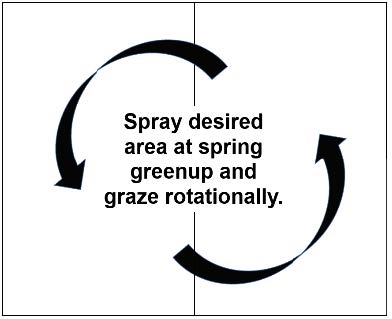
Two recent university field studies confirmed a significant reduction in reproductive tillers (stems and seedheads) in tall fescue treated with metsulfuron, which can lower the incidence of overall toxin consumption by livestock. Also, the natural decline of forage crude protein and digestibility during spring was significantly slowed in treated versus untreated pastures. Both studies found that treated fescue pastures supported significant increases in the average daily gain of steers through mid-summer. While forage quality is likely to be higher, the overall forage yield in treated fields will usually either trend lower or be significantly lower than in untreated fields (Williamson et al. 2016). However, much of the “lost” forage was stems of limited digestibility.
Herbicide application timing and rate are important to achieve the desired results. Severe clover injury or death is likely under normal herbicide rates, and overapplica- tion could result in severely stunted fescue. Among grasses, metsulfuron-methyl selectively affects tall fescue and timothy, but most other common pasture grass species are unaffected (photo 3).
Photo 3. Side-by-side comparison of fescue treated with Chapparal (left) versus untreated (right). (Photo credit: Pat Burch, Christiansburg, Virginia )

The following herbicide products, rates, and application timings are currently recommended for chemically suppressing tall fescue seedstalks and seedheads. There are no grazing restrictions with these products.
- Apply Chaparral (2.0 ounces per acre) or Cimarron Plus (0.5 ounce per acre) herbicide after initial green- up when grass height is approximately 6 inches tall. Later applications may still be effective; however, the seedhead suppression will be less effective and the number of seedheads could be noticeably higher. In addition to suppressing seedheads, this timing can help control many annual and biennial weed species (Bayer n.d. and Corteva 2022).
After spraying, foliage may turn yellow before energy shifts to vegetative growth. This transition may last up to two weeks.
Haymaking
Making pasture hay can be a valuable option for dealing with the spring flush, one that also provides stored feed, encourages uniform vegetative regrowth, and potentially helps to manage some weed species (photo 4). To optimize the use of pastures for making pasture hay, it helps to determine ahead of time the fields (or portions of fields) on which the hay will be made. Whole fields can be excluded from rotations by shutting gates, and temporary electric fences can be used to restrict access to portions of fields. Ideally, concentrating grazing on the pasture area not designated for haymaking will enable the grazed forage to remain more vegetative and higher in nutritive value (figs. 9-11). The higher stocking density may also reduce selective grazing of more palatable plant species, enabling better forage diversity in the pasture.
Photo 4. Haymaking can play an important role in managing the spring flush. (Photo credit: Matt Booher, Virginia Cooperative Extension)

Generally, making hay before seedheads emerge will result in hay with higher forage quality. It will also allow time for significant vegetative regrowth during favorable weather conditions (fig. 10). Farmers who make pasture hay will often graze livestock on these fields for the remainder of the season after hay is removed. When doing this, it is important to allow plants to regrow to at least 8 to 10 inches tall before turning livestock in to graze (fig. 11).
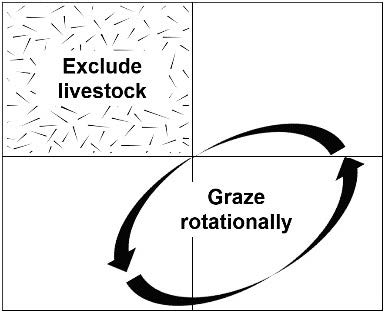
Figure 10. Early June.
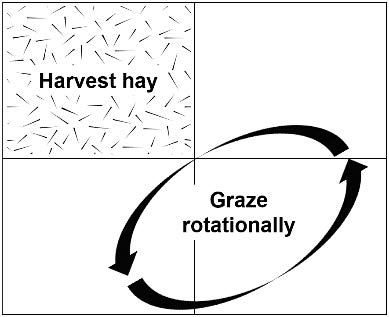
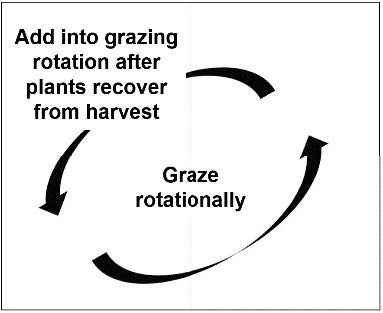
Making hay on pasture can also be valuable for removing grass competition to enable establishment of seedling legumes, such as clover. Downsides of haymaking include: the removal of soil nutrients that must eventually be replaced and the high costs of equipment, fuel, and labor to make hay. Also, wet, cool weather conditions often hamper early haymaking.
Clipping
Clipping can aid in managing the spring forage supply and improve forage quality by creating a more uniform and vegetative pasture. Additionally, clipping pastures can help reduce the toxicity of fescue pastures by removing seedheads that are high in ergot alkaloids.
Clipping pasture can also reduce grass competition, which can enable seedling establishment of legumes, such as clover. There are three common strategies for clipping pasture:
1. Set aside a portion of the pasture to be clipped at the appropriate time, and concentrate grazing on the remaining pasture (fig. 12). This can enable better pasture management, including rotational stocking, within the grazed area. Ideally, concentrating grazing on the pasture area not designated for clipping will allow forage to remain more vegetative and higher in nutritive value. The higher stocking density may also reduce selective grazing of more palatable plant species, enabling better forage diversity in the pasture. It is recommended to clip pastures soon after seedhead emergence is prevalent in the field. This encourages regrowth while growing conditions are still favorable. Clip pastures to leave about six to eight inches of vegetation.
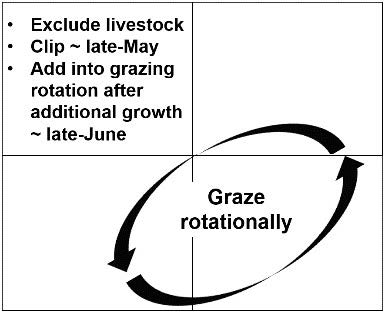
2. Keep all pastures in the spring grazing rotation and clip each paddock after animals have been rotated to a new paddock (fig. 13). This is commonly practiced on grazing dairies or grass-finishing operations where high animal performance is required. Livestock are typically turned onto a new paddock for a relatively short grazing period of one to three days. This allows animals to select the highest quality plant parts before being rotated to a new paddock. Clipping is usually performed a day or two after grazing, once livestock have been rotated to a new paddock. Clipping pastures at a height of six to eight inches removes less palatable plant parts such as stems, promotes vegetative regrowth, and helps to suppress certain weeds. Done this way during the spring flush, multiple pasture clippings can help maximize forage yield, quality, and uniformity, while keeping animal performance at consistent, optimum levels. Overall, this method of clipping is labor- and fuel-intensive and probably not cost-effective, except for forage-based dairy or finishing operations.
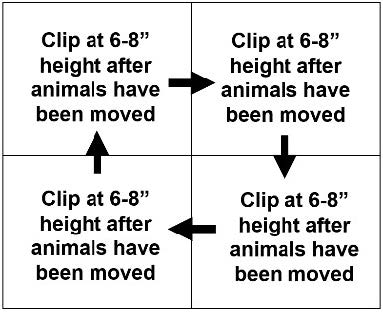
3. Keep all pasture in the spring grazing rotation and clip all paddocks at once, after the forage supply exceeds demand (fig. 14). It is common for farmers toclip pastures after the spring flush is over and plants have gone to seed, often July or later. While this may be a good time of the year for many from a labor standpoint, it is not optimum from an agronomic standpoint.
Growing conditions are typically not favorable for cool-season grasses, so regrowth potential is low. By July, livestock will have already spent a month or more grazing poor quality pastures that, in Virginia, often contain a high proportion of toxic fescue. If you decide to clip using this strategy, it is recommended not to clip plants shorter than four to six inches tall, but experience suggests that clipping too high (above 8 to 10 inches) can leave a stiff, sharp stubble that can hinder grazing.
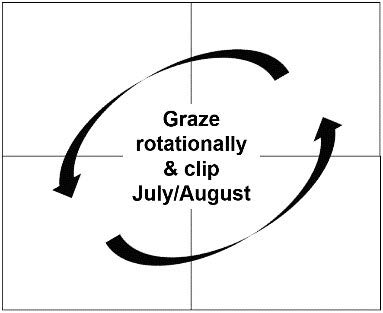
Accelerated pasture rotation
Many producers accelerate their pasture rotation during spring. In an accelerated rotation, animals often only have time to select the tender plant tips before they are rotated to new pasture. It is common to see a grazing period of anywhere from one to five days per paddock used in an accelerated rotation when pasture is growing quickly.
For example, in an eight-paddock grazing system, livestock on an accelerated schedule might be rotated every three days during rapid growth in spring, such that each paddocks rests 24 days before being grazed again (fig. 15). Conversely, livestock might later be allowed to graze six days per paddock during summer and fall, providing 48 days of rest to each paddock in the system (fig. 16). In other words, in this example of accelerated rotation in an eight-paddock system, cattle would cycle through the entire farm roughly two times between April 1 and June 15, while the same herd may cycle the farm only once from June 15 through August 1.


An accelerated rotation schedule can help prevent overgrazing when plant photosynthetic rates are lower, pasture canopy height is short, and forage availability is low in early spring (photos 5 and 6). During the peak of the spring flush, an accelerated rotation may enable more uniform grazing across a greater percentage of the farm, help to keep plants vegetative, and ensure adequate animal nutrition as plants mature and forage quality declines. However, an accelerated rotation does not typically eliminate the need for some other method to manage an excess forage supply. In fact, the relatively low grazing intensity that occurs under an accelerated rotation should encourage plant growth and increase the overall forage supply.
Rotating spring calving herds can sometimes be challenging since cows with calves — especially those under 3 or 4 days old — can be hesitant to move.
Usually, this hesitation only lasts a couple of days after calving, as cows grow eager to rejoin the herd and calves become more mobile. However, even older calves can get confused or flighty if they are naive to pasture rotation. The most common way to deal with these situations is to leave the gate or gap open for a day or two after giving access to new pasture, allowing individuals to move at their own pace. Given a little time, even cows with very young calves will typically retrieve them and rejoin the herd. If you cannot leave the gate open, still avoid pressuring livestock. Taking extra time to move the herd without provoking a flight response will help prevent animals from going the wrong direction and minimize cows and calves from becoming separated. Some managers have found these additional recommendations helpful when moving cows with calves:
Rotate animals in the early morning or evening when they are typically inclined to move and cows and calves are naturally paired-up.
Wait for the herd to gather at the gate before moving to another pasture. This allows cows and calves time to pair up.
When moving between two pastures that share a fence, try to keep the first cows that pass through the gate from running along the shared fenceline. This prevents calves on the other side of the fence from following them in the wrong direction.


Incorporate a warm-season perennial grass paddock
Warm-season perennial grass species produce most of their growth in the summer (fig. 17). Switchgrass, indiangrass, and big bluestem are native to the eastern United States and are commonly used in pure or mixed warm-season grass stands throughout Virginia for grazing, haymaking or both. Bermudagrass is an additional option for the southeastern part of Virginia. When warm-season grasses are grown on a small portion of total pasture acres (typically less than 20%), it is possible to shift some forage production from spring to summer and better balance seasonal forage supply with livestock demand. Grazing these forages in mid-summer gives valuable rest to cool-season pastures. When grazed in late summer, warm-season perennial pastures also enable stockpiling of perennial cool-season pastures for grazing in late fall and winter. For more information on using native warm-season grasses, see the University of Arkansas publication MP538, Native Warm Season Grasses for Forage (https://www.uaex.uada.edu/publications/pdf/MP538.pdf, Jennings et al. 2016).
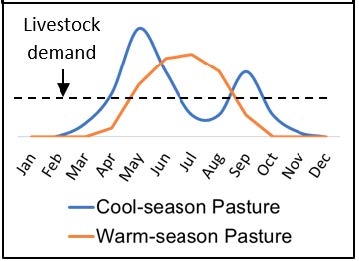
Increasing livestock numbers and forage demand
To better match forage demand with supply, increasing animal numbers by importing stocker cattle in spring or retaining some weaned steer calves through the winter may be viable options for some operations. In most cases, the relatively quick and dramatic shift away from the high pasture abundance of springtime prevents the addition of animals above a farm’s normal summer carrying capacity.
Fall calving cow herds with calves have a higher forage demand during the spring flush than late-winter calving herds (about 13% higher) (Gadberru 2018). Due to the toxicity of fescue in spring and summer, fall calving herds generally have higher conception rates than late winter or spring calving herds, and they have higher net returns (Griffith et al. 2017). Shifting from spring to fall calving may therefore offer multiple benefits to overall management and profitability for some operations, but there are additional factors that should inform any deci- sion to change calving seasons.
Summary
Dealing with the spring flush requires flexibility and adaptation. Good management early in the year can help to manage the volume of grass in spring while maxi- mizing season-long pasture productivity. Proper grazing management during the spring flush can help to better match forage quality to the needs of livestock, extend the grazing season, and ultimately reduce winter feed costs.
References
Bayer Environmental Science. n.d. “Cimarron Plus.” https://www.environmentalscience.bayer.us/-/media/prfunitedstates/documents/resource-library/ product-labels/cimarron-plus.ashx.
Booher, M. R., J. K. Benner, and D. A. Fiske. 2017. Using a Summer Stockpiling System to Extend the Grazing Season. Blacksburg, VA: Virginia Coopera- tive Extension. https://www.pubs.ext.vt.edu/CSES/ CSES-201/CSES-201.html.
Burdine, K., D. Trimble, G. Lacefield, R. Smith, B. Witt, and T. Keener. 2006. Forage Enterprise Budgets. University of Kentucky Department of Agricultural Economics. https://agecon.ca.uky.edu/files/hay_ forage_budget.xls.
Corteva Agriscience. July 2020. “Chaparral.” https://s3- us-west-1.amazonaws.com/agrian-cg-fs1-production/pdfs/Chaparral1t_Label.pdf.
Gadberry, S. 2018. Beef Cattle Nutrition Series Part 3: Nutrient Requirement Tables. University of Arkan- sas. MP 391. https://www.uaex.uada.edu/publications/pdf/MP391.pdf.
Griffith, A. P., C. N. Boyer, G. W. Henry, J. A. Larson, S. A. Smith, and K. E. Lewis. 2017. Fall Versus Spring Calving: Considerations and Profitability Comparisons. University of Tennessee Extension. W 419 4/17. https://extension.tennessee.edu/publications/Documents/W419.pdf.
Griggs, T. 2010. “Herbage Utilization Following Low and High Allowances of Stockpiled Pasture and Three Dates of Initiation of Spring Grazing” (unpublished manuscript). West Virginia University.
Jennings, J., K. Simon, M. Mobley, H. Chaney, and D. Hubbell. 2016. Native Warm-Season Grasses for Forage. University of Arkansas. MP538. https://www.uaex.uada.edu/publications/pdf/MP538.pdf.
McCann, M. A. “Grass Tetany Season Is Here,” Live- stock Update, Virginia Cooperative Extension, April 2009. https://www.sites.ext.vt.edu/newsletter-ar- chive/livestock/aps-09_04/aps-0404.html/.
Meteer, W. T. 2017. “Mitigating the Challenges of Graz- ing Lush, Spring Forages.” Paper presented at the 15th Heart of America Grazing Conference, Quincy, IL, January 2017. https://uknowledge.uky.edu/cgi/viewcontent.cgi?article=1147&context=ky_graz-ing.
Oregon State University. n.d. “Understanding Grass Growth and Regrowth for Improved Management.” https://forages.oregonstate.edu/regrowth/how-does-grass-grow/developmental-phases.
Pasha, T. N., E. C. Prigge, R. W. Russell, and W. B. Bryan. 1994. “Influence of Moisture Content of Forage Diets on Intake and Digestion by Sheep.” Journal of Animal Science 72 (9): 2455-63.
Rasby, R. J., B. E. Anderson, and R. F. Randle. 2010. “Bloat Prevention and Treatment in Cattle.” University of Nebraska-Lincoln Extension Publications. https://extensionpublications.unl.edu/ assets/html/g2018/build/g2018.htm#target.
Williamson, J. A., G. E. Aiken, E. S. Flynn, and M. Barrett. 2016. “Animal and Pasture Responses to Grazing Management of Chemically Suppressed Tall Fescue in Mixed Pastures.” Crop Science 56: 2861- 69.
Acknowledgments
Thank you to John Fike, professor and forage specialist, Virginia Cooperative Extension; Elizabeth Baldwin, agent, Agriculture and Natural Resources, and Animal Science, and unit coordinator, VCE Page County Office; and Tom Stanley, agent, Agriculture and Natural Resources and Farm Business Management, VCE Rockbridge County Office, for their careful review of this publication to ensure its scientific accuracy and practicality.
Virginia Cooperative Extension materials are available for public use, reprint, or citation without further permission, provided the use includes credit to the author and to Virginia Cooperative Extension, Virginia Tech, and Virginia State University.
Virginia Cooperative Extension is a partnership of Virginia Tech, Virginia State University, the U.S. Department of Agriculture (USDA), and local governments, and is an equal opportunity employer. For the full non-discrimination statement, please visit ext.vt.edu/accessibility.
Publication Date
May 8, 2023



